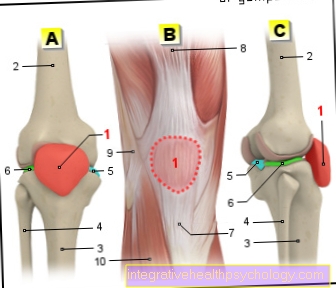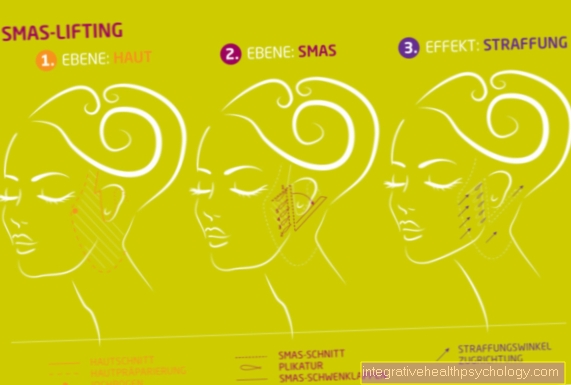Blurred vision - what's behind it?
What do we mean by blurred vision?
Blurred vision is a visual disorder in which there is a change in optical perception. The person concerned is no longer able to see clearly and, depending on the severity of the visual impairment, only recognizes the contours and shapes of the object he is fixated on. Blurred vision can occur when looking into the distance or when looking close. However, there may also be a general lack of visual clarity that affects all visual attitudes. The following are the various causes of decreased visual acuity.

causes
Tension
In order to see an object or its surroundings clearly, an interaction of different eye muscles is necessary. The outer muscles of the eye, which run around the eye, are responsible for the movement of the eye. Muscles of the eyelid ensure that it opens and closes, as happens with every blink of the eye but also when the eye is actively squeezed shut. In addition, there are inner eye muscles that are not controlled by us arbitrarily and that regulate the dilatation and constriction of the pupil as well as the adjustment of the eye lens. All of these muscle-controlled components play an important role in sharp vision. In order to be able to focus on an object clearly, the eyes must be in the correct position. The pupil restricts the incidence of light and it is only possible to see sharply by adjusting the lens curvature to the distance of the object.
Like any other muscle, the eye muscles can be tense. This tension can be caused, for example, when the person's gaze is very rigid over a long period of time, for example when looking at a screen for a long time in the same eye position. Tension in other muscle regions such as the forehead, jaw or neck can also be transferred to the eye muscles. Since these muscle regions are in the immediate vicinity of the eyes and are closely connected to the eye muscles, immobility and therefore tension in these muscles also affects their surroundings.
Read here how to best relieve tension in the neck.
After LASIK surgery
LASIK stands for laser in situ keratomileusis. This is understood to be an eye operation that is intended to restore normal vision. During this operation, the cornea is opened with a laser and part of the lower corneal layer is removed. The cornea is then closed again. This results in a correction of the degree of curvature of the cornea. This degree of curvature, together with the curvature of the eye lens, determines the incidence of light on the retina of the eye. The incidence of light on a certain point of the retina enables clear vision. If the curvature of the cornea is too strong or irregular, the light does not hit the right place on the retina and a fixed object cannot be seen clearly.
However, there are risks associated with LASIK surgery. For example, infections as well as scarring or instability of the cornea can occur. It can also happen that there is a miscorrection and the cornea has an unsuitable degree of curvature even after the operation. All of these factors can lead to blurred vision.
Read more about here Complications of LASIK surgery
After cataract surgery
Cataract, also known as cataracts, is a clouding of the lens of the eye. This cloudiness can be removed by a surgical procedure in which the core of the lens or the entire lens is replaced. However, there are also risks associated with this operation. A so-called cataract occurs in about 30% of patients, i.e. that patients see cloudy again after cataract surgery. The reason for this is a kind of scar that forms at the point where the new lens nucleus was inserted. In rarer cases, the retina becomes detached. As with any operation, an infection can occur during cataract surgery, which in turn can lead to blurred vision.
With diabetes
Diabetes can be associated with many comorbidities, especially if the blood sugar is not optimally adjusted over a long period of time. Diabetic retinopathy is a common one. The increased sugar content in the blood leads to vascular damage via various mechanisms. If this vascular damage occurs in the area of the retina, where the vessels are particularly fine, this leads to pathological deformities of the retina and its blood vessels. These anomalies can remain asymptomatic for a long time, but later lead to deterioration in vision and even blindness. It is therefore of particular importance that diabetics adjust their blood sugar optimally and have ophthalmological examinations carried out regularly.
For thyroid diseases
The thyroid regulates many functions of the body through hormone release. If there is a disease of the thyroid gland, such as an overactive or underactive condition, this can lead to visual disturbances such as blurred vision through many metabolic impairments. In this case, the visual impairment is often accompanied by other symptoms that should be assessed and classified by the doctor through detailed questioning of the person affected.
One form of hyperthyroidism is Graves' disease. It is accompanied by an enlargement of the thyroid gland, palpitations and exophthalmos. Exophthalmus is the excessive leakage of the eyeball from the eye socket. This can then lead to impaired eye mobility, which in turn can result in impaired vision.
Through stress
Stress can be a contributing factor to the appearance of blurred vision. Stress can cause the body's functions to be imbalanced. If relaxation and recovery phases are omitted, numerous malfunctions can occur, which can also be expressed in blurred vision. For example, tension often occurs in stressful phases in life, which, as described above, can negatively affect eyesight.
From dry eyes
The tear fluid keeps the eye constantly moist. Its job is to rinse and disinfect the eye. It also helps to create a smooth and even surface on the eye and supplies the cornea with nutrients. Insufficient tear fluid can result in a rough surface of the eye. As a result, there are no longer optimal conditions for incidence of light and image processing, and vision may be blurred.
Read here what you can do against dry eyes.
Through contact lenses
Blurred vision when wearing contact lenses can have several causes. On the one hand, it may be that the strength of the contact lenses does not match the patient's visual acuity adjustment. Another reason could be eye irritation from contact lenses. Especially when using hard contact lenses, this can lead to irritation of the outer eye. This is then accompanied by a feeling of foreign body and possibly itching and tearing of the eye.
Can blurred vision be a sign of pregnancy?
Pregnancy is associated with many hormonal changes that can affect the eye as well. The composition of the tear fluid can change, which can cause dry eyes. The eyesight can also change during pregnancy due to the accumulation of fluid in the lens, for example. These changes are usually not threatening and regress again after pregnancy. However, if there is a sudden, serious deterioration in vision, this should be clarified immediately. The cause can then be, for example, so-called preeclampsia, which is associated with increased blood pressure, which can lead to visual problems and is considered a serious complication for mother and child.
Duration
The duration depends on the cause of the blurred vision and how to remedy it. If the cause is identified quickly and treated appropriately, the symptoms will last for a short time. In the case of tension, this is often only discovered late as the cause of the unclear vision, so finding a therapy can take a long time. Even in the case of eye infections, depending on the severity and cause, the healing may not take place immediately, as drug therapy must first be carried out and the eye irritation may persist for a few days.
accompanying symptoms
The blurred vision can be accompanied by other complaints. The most common include headaches, fibrillation and dizziness, which are discussed in more detail below. However, pain in the eye area can also occur, for example due to an infection or irritation after an operation. As part of the pain, the eye may also be red, itchy, and watery. The leakage of a purulent fluid can also be an indication of an infectious process in the eye.
Are you concerned about having an eye infection? Read more on the subject here Eye infection.
a headache
Headaches can be both a cause and a consequence of blurred vision. If, for example, there is tension in muscles or an incorrect posture of the head, this can cause headaches and impaired visual acuity. If the ametropia is present, which is compensated to a certain extent by constant tension of the inner eye muscles, this can also lead to headaches. In this case, an examination by the optician and the preparation of a suitable visual aid can lead to quick relief of the symptoms.
In rare cases, there may be an infection of the eye that spreads to the meninges. Inflammation of the meninges causes very severe headaches and other symptoms such as fever and neck stiffness.
flicker
If flicker occurs with blurred vision, it could be an indication of a problem in the retina. The retina is responsible for transmitting the light stimuli to the optic nerve. If there is a disease of the retina that results, for example, in detachment or swelling, this can be transferred to the optic nerve and perceived by the person concerned as flickering. Flashes of light or the perception of “soot rain” are typical symptoms of a retinal detachment.
Here you can find more information about Retinal Detachment Symptoms.
Flickering and unclear vision are also common in patients with migraines.
dizziness
Blurred vision can be accompanied by dizziness. Optical perception is an important component that is used for orientation. If it disappears because, for example, eye mobility is restricted or ametropia is present, visual information can no longer be adequately processed by the brain, which can lead to dizziness. Severe headaches, such as those associated with migraines, can also cause blurred vision and dizziness. In general, dizziness is a very common symptom and can have many causes, which can be harmless or serious and always requires clarification.
Dizziness can be a serious symptom of poor blood flow to the brain. Read here more on the subject.
Eye pain
Eye pain can be a symptom of blurred vision. Depending on the cause, the pain in the eye area has a different origin. For example, is inflammation, e.g. the conjunctiva, the trigger for blurred vision, there is inflammation-related irritation of the eye, which can be very painful. A dry eye can also cause pain, as the eye movement can then no longer go smoothly.
In the case of a nervous cause, eye pain and blurred vision can also co-exist. For example, pain behind the eyeball when moving the eyes, which is accompanied by a loss of vision, is a typical initial symptom of multiple sclerosis.
Unilateral appearance of blurred vision
Depending on which part of the eye and thus the visual process is impaired, blurred vision can only occur in one eye. For example, a disease of the retina or the optic nerve behind it can be unilateral. A process that causes the normally translucent structures of the eye - cornea, lens, and vitreous humor - to become cloudy can also only take place in one eye. Far or near-sightedness can only affect one eye. The error can then be compensated for by the healthy eye or, if the ametropia is too severe, it results in blurred vision.
Click here for the main articles Symptoms of Farsightedness and Myopia.
Neurological diseases can also lead to unilateral and bilateral eye problems. In the case of multiple sclerosis, unilateral inflammation of the optic nerve is often an early symptom. This then leads to a decrease in visual acuity, loss of visual field, pain when moving the eyes and a disruption of color vision. A mass can also lead to blurred vision if it presses on part of the visual pathway and thus impairs the transmission of information from the eye to the responsible region in the brain.
diagnosis
The first step in making the diagnosis is taking the medical history, i.e. The doctor asks the patient about their complaints, previous illnesses and risk factors for certain eye diseases, for example diabetes or high blood pressure, as these diseases can lead to circulatory disorders in the eye.
This is followed by the physical exam. In the case of ophthalmology, there are various examination options to determine the patient's visual acuity. A simple aid is the eye chart, on which the patient should recognize the symbols depicted on it from a fixed distance. In addition, an examination of the eye can be carried out, initially by carefully touching the eyeball by the doctor to determine whether the intraocular pressure is possibly too high, or by using various ophthalmic devices. With the help of an ophthalmoscope, the back of the eye, where the retina and the beginning of the optic nerve are located, can be assessed. By using a slit lamp, the doctor is able to inspect individual areas of the eye with high magnification and direct lighting. The intraocular pressure can be precisely determined using tonometry. A general physical exam of the patient can also provide helpful clues as to the source of the symptoms, such as measuring blood sugar to determine whether they have diabetes.
therapy
The therapy depends on the cause of the visual impairment.
If the problem is in the retina or optic nerve, adequate treatment should be given as soon as possible to avoid long-term damage. For example, a retinal detachment can be treated with a laser treatment in which the retina is fixed again. If the optic nerve or another area of the eye is infected, antibiotic or antiviral therapy may be necessary. In addition, the eye should then be spared by first covering it and possibly cooling it. Eye drops can also provide relief from dry or itchy eyes.
Here you can find out about the Retinal detachment therapy to inform.
If there is ametropia, the type and cause should first be determined. A visual aid, such as glasses or contact lenses, can then be used. Laser operations can also correct ametropia and replace the need for an aid.
If there is a clouding of a translucent structure, this can be removed with an operation. In the case of the lens, cataract surgery is performed. If there is a cloudy liquid in the vitreous humor, different approaches can be taken. A wait-and-see behavior is often enough, as the cloudy liquid is often absorbed once the cause has been eliminated. In more severe cases, it may be necessary to remove the vitreous, especially if the vitreous disease spreads to the retina.
If drooping eyelids are the cause of blurred vision, they can be treated with the help of eyelid tapes.





























